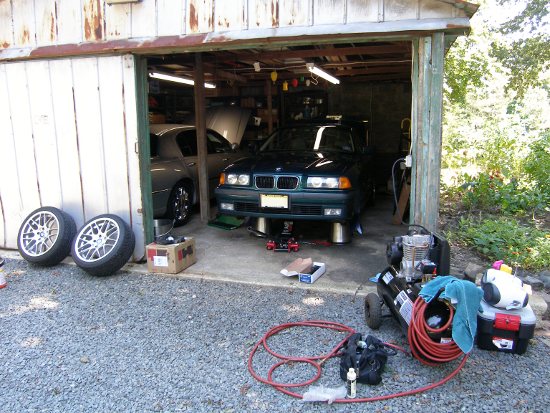Sunday, August 29, 2010
Front Brakes
The last few times I washed the car I noticed concentric grooves in the front right rotor, which is caused by the pad wearing down to the level of the rivets that fasten the pad to the backing plate. The brake wear indicator is on the left front and hadn't tripped but a cursory inspection of the pad thickness on both sides convinced me it was time to do a brake job. I ordered OE pads, rotors, and a wear sensor just in case I got to the job after it tripped. The parts came in on Friday and I performed the work today.
 All in all this was a standard front brake job.
I did notice some asymmetry in the wear patterns, however. The right side
pads were worn more than the left, and the outer right side pad was worn down
to the thickness of a quarter. Had that pad been monitored by a sensor
it would have tripped at least 500 miles ago. I'm not sure why the right front
pads took more of a beating than the left, but it may have something to do
with a sticky caliper. This hints at a need to overhaul the calipers during
the upcoming front end overhaul. This will naturally add some cost to the
job, but since I had plans to install new brake lines on the front during
the overhaul anyway I won't incur any additional labor.
All in all this was a standard front brake job.
I did notice some asymmetry in the wear patterns, however. The right side
pads were worn more than the left, and the outer right side pad was worn down
to the thickness of a quarter. Had that pad been monitored by a sensor
it would have tripped at least 500 miles ago. I'm not sure why the right front
pads took more of a beating than the left, but it may have something to do
with a sticky caliper. This hints at a need to overhaul the calipers during
the upcoming front end overhaul. This will naturally add some cost to the
job, but since I had plans to install new brake lines on the front during
the overhaul anyway I won't incur any additional labor.
I took a bit more time to clean up the caliper carrier brackets in a bucket filled with water and some of the same citrus degreaser I used during the rear suspension overhaul. Even after I scrubbed with the bristle brush I noticed that some of the gunk (technical term for dried grease and brake dust) simply would not come off unless I attacked it with a small wire brush. BMW specifically recommends against doing that for some reason, but I used a brass brush and went easy on it. I let the parts dry in the sun and then applied a new coating of high temperature grease to the areas where the pads ride in the bracket. Of course, I also applied grease to the tabs of each pad as recommended by BMW during the installation process.
The bonus of the day was that I managed to save the existing wear sensor. The thickest of the four pads I removed just happened to be on the inner left side (the one with the sensor) and the pad was just above the thickness that would have started sensor wear. Since there's no sense in replacing an otherwise intact sensor I just cleaned it up with a rag and reinstalled it. I bought the part anyway so this technically didn't save me any money this time around but it will in the long haul. The sensor is only $12, but that's better in my pocket than anywhere else, especially in this economy.
As I've said more than once, brake jobs are a great place to save money because they are performed relatively frequently and are quite expensive at the dealer. Book labor is 2.0 hours per axle so I saved $128 * 2 or $256 doing this job myself. My discounts from Ticher also saved 20% of the parts cost or $58. This brings the DIY dividend to $314. I'm normally able to do this job in under two hours but I took some extra time to degrease the parts so I managed 2+15 on the clock. That works out to $142 per hour, which is far in excess of the $100/hr I usually need to justify working on the car myself. Not a bad way to spend a few hours, wouldn't you say?
The last front brake job was done at 165475, which means this set lasted 30795 miles. Had I waited until the sensor tripped I probably could have crossed over 31K miles but I'm very happy with anything over 30K.
Mileage: 196270, Parts: $228, Labor Saved: $256, Parts Saved: $58



